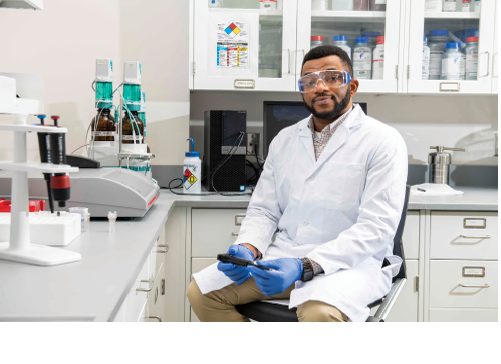
A researcher at Missouri University of Science and Technology, Rolla, is looking to solve the problems of tomorrow by using chemistry from the distant past. Assistant Professor of Chemical and Biochemical Engineering Dr. Monday Uchenna Okoronkwo is investigating how to mimic the chemistry and composition of ancient Roman concrete while also applying modern technology to make today’s slabs, structures and elements even better.
“Every technology that you look at these days stems from what has already existed,” he says. “You can decide to scrap old technology and start anew, but I think the wisest thing to do is learn from what is good from the old technology, discard what is bad, and then combine the good from both the older approaches and modern approaches to generate the future.”
Dr. Okoronkwo was recently presented the National Science Foundation’s Faculty Early Career Development (CAREER) Program award, providing about $675,000 to support his project. According to the Foundation, the CAREER program “offers the NSF’s most prestigious awards in support of early-career faculty who have the potential to serve as academic role models in research and education and to lead advances in the mission of their department or organization.”
Dr. Okoronkwo says his research has the potential to transform the cement industry. His work could make concrete more durable while also cutting back on carbon emissions associated with finished slabs, structures and elements. “Our target is to design a new generation of cementitious material,” he explains. “Roman concrete can withstand aggressive environments. In the modern day, we now have chemical additives we can add to increase the flexibility and flow properties of the concrete. This project is aimed at harnessing the best properties of both ancient and modern approaches.”
The key to having lower carbon emissions, which is also central to mimicking the ancient Roman concrete, lies in the strätlingite-based cementitious binder the professor aims to develop. With this type of binder, Dr. Okoronkwo says the percentage of lime to alumina and silica requires approximately half of what is used when developing binders for modern concretes, and it would be made at much lower temperatures than the traditional portland cements.
Having less lime and using lower temperatures will lead to less carbon being emitted throughout the process. Dr. Okoronkwo plans to develop versions of this cement for both marine and land uses. “There will be so many possible applications for this new cement,” he affirms. “Consider military uses, offshore hydroelectric power systems, underwater construction, and bridges and neighborhoods exposed to hurricanes and extreme weather. This new material can be as resilient as what was used by the ancient Romans 2,000 years ago, but it will be even better thanks to the modern technology and methods we can now apply.”
LIMESTONE CALCINED CLAY CEMENTS STUDY
Concurrent with the CAREER funding announcement, NSF awarded a Graduate Research Fellowship to Abigail Kienzle ‘23, a Civil Engineering major and member of the Honors Program at Clarkson University in Potsdam, N.Y. Her proposal focuses on characterizing the hydration reactions for limestone calcined clay cements (LC3), which are presented as a sustainable and lower-carbon alternative to traditional cements. Her research will answer basic questions about how LC3 cements harden, how the underlying processes can be controlled to produce desirable behavior for construction, and how this can help achieve a new generation of resilient and sustainable civil infrastructure.
“I hope my work both now and in the future will promote more sustainable use of concrete,” says Kienzle, consistent with the Clarkson Wallace H. Coulter School of Engineering’s guiding principle of “Technology Serving Humanity.”
The LC3 work follows her Honor’s Thesis on the solidification behavior of rapid-setting calcium sulfoaluminate cements with Assistant Professor of Civil & Environmental Engineering Robert Thomas. Kienzle’s research was featured in a co-authored publication in Construction and Building Materials in 2022 and she presented her work twice at American Concrete Institute Conventions. In 2022, she was awarded the ACI Concrete Practitioner Fellowship. At Clarkson, she has been active in the American Society of Civil Engineers Student Chapter, serving as president in 2022 and ASCE Concrete Canoe team captain.
WIDE-RANGING SUPPLEMENTARY CEMENTITIOUS MATERIALS PERFORMANCE SPECIFICATION
ASTM International Committee C09 on Concrete and Concrete Aggregates is balloting WK70466, New Specification for Supplementary Cementitious Material for Use in Concrete, covering a broad range of binders and offering a better method of gauging their potential than ASTM C618, Standard Specification for Coal Ash and Raw or Calcined Natural Pozzolan for Use in Concrete methods.
The proposed performance specification will ease adoption of new SCMs as availability of established agents diminishes, according to Houghton, Mich. engineer Larry Sutter, who leads WK70466 development under ASTM C09.24, Subcommittee on Supplementary Cementitious Materials and serves as the inaugural NEU, An ACI Center of Excellence for Carbon-Neutral Concrete board president. “For a variety of reasons, historic sources of SCMs, like coal fly ash from electric power generation, are in short supply and new materials are emerging. These new materials do not fall under existing specifications, leading to the need for new specifications,” he observes. “Rather than writing a new specification for every emerging material, we are writing a performance specification that can be used to cover the full range.”